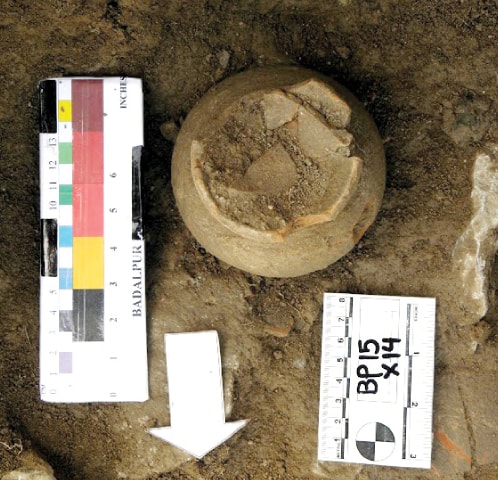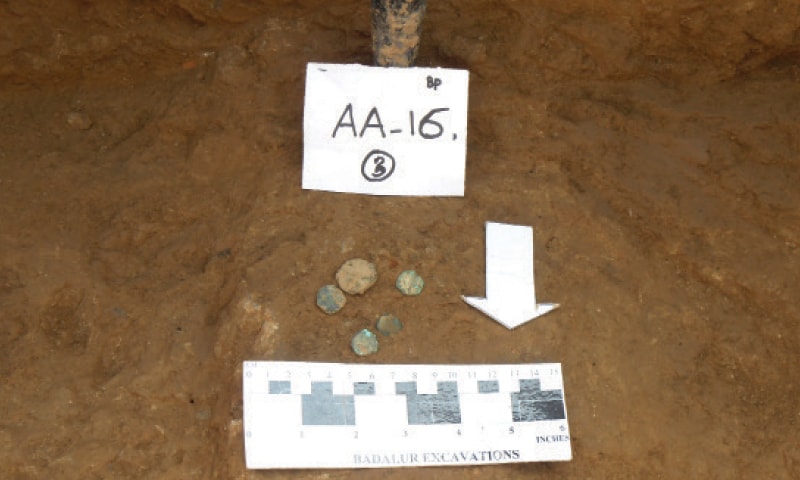Kabira
BANNED

- Joined
- Jul 12, 2014
- Messages
- 14,383
- Reaction score
- -20
- Country
- Location
TAXILA: A stupa dating back to the 3rd Century BC was discovered at the ancient Buddhist site of Badalpur near Taxila during excavations carried out by the Taxila Institute of Asian Civilisations (TIAC) of Quaid-i-Azam University.
The stupa measuring 25x25 was discovered on the southern side of the main monastery with a centre water tank at the ancient Buddhist site. Coins, pottery and metal objects have also been excavated from the site by graduate and doctorate students of the TIAC. The students were led by the institute’s director, Professor Dr Ashraf Khan, Assistant Professor Dr Sadid Arif and Coordinator Mohammad Ibrahim.
Professor Dr Ashraf Khan told media men that the newly discovered monastery was built in Kushan workmanship style known as ‘diaper masonry’, consisting of thin neatly placed layers of schist interspersed with large blocks of stone as well as semi-ashlar masonry.
He said the cells of the monastery are plastered with mud mortar, the first of its kind seen in the Taxila Valley.
In response to a query, Dr Khan said the discovery of metal objects showed the craftsmanship of the people living in the area between the first and fourth century.
Dr Khan said six copper coins from the Kushan period have been discovered in the excavations. He said that according to the carbon study of the newly discovered stupa carried out by the University of Wisconsin-Madison dates it between the 3rd century BC to 1st century AD.
He said during the last season of the excavation, a good number of antiquities such as a bust of Buddha in stucco, copper coins, bones, charcoal, iron objects and pottery were discovered.
Unveiling the archaeological significance of the site, he said the site was early mentioned by Alexander Cunningham in 1863, the then director, Archaeological Survey of India, during his expedition to Gandhara.
The first excavation at the site was carried out in 1916-17 by Natisa Aiyar, superintendent of Frontier Circle, while the second was carried out from 2005 till 2009 by Federal Archaeology in collaboration with Taxila Institute of Asian Civilisations, Quaid-i-Azam University.
He said five seasons of excavations had been successfully conducted by the institute at this ancient Buddhist site.
The most remarkable discovery was an iron nail and animal bones which revealed that Gandhara people knew the use of different metals and that Buddhists used to eat meat, said Dr Khan.
“History of Taxila should be rewritten in the light of the new and substantial evidence obtained,” he said. Dr Khan said despite limited resources, the university had planned to excavate and preserve the whole site.
3rd Century BC stupa discovered near Taxila - PakTribune
The stupa measuring 25x25 was discovered on the southern side of the main monastery with a centre water tank at the ancient Buddhist site. Coins, pottery and metal objects have also been excavated from the site by graduate and doctorate students of the TIAC. The students were led by the institute’s director, Professor Dr Ashraf Khan, Assistant Professor Dr Sadid Arif and Coordinator Mohammad Ibrahim.
Professor Dr Ashraf Khan told media men that the newly discovered monastery was built in Kushan workmanship style known as ‘diaper masonry’, consisting of thin neatly placed layers of schist interspersed with large blocks of stone as well as semi-ashlar masonry.
He said the cells of the monastery are plastered with mud mortar, the first of its kind seen in the Taxila Valley.
In response to a query, Dr Khan said the discovery of metal objects showed the craftsmanship of the people living in the area between the first and fourth century.
Dr Khan said six copper coins from the Kushan period have been discovered in the excavations. He said that according to the carbon study of the newly discovered stupa carried out by the University of Wisconsin-Madison dates it between the 3rd century BC to 1st century AD.
He said during the last season of the excavation, a good number of antiquities such as a bust of Buddha in stucco, copper coins, bones, charcoal, iron objects and pottery were discovered.
Unveiling the archaeological significance of the site, he said the site was early mentioned by Alexander Cunningham in 1863, the then director, Archaeological Survey of India, during his expedition to Gandhara.
The first excavation at the site was carried out in 1916-17 by Natisa Aiyar, superintendent of Frontier Circle, while the second was carried out from 2005 till 2009 by Federal Archaeology in collaboration with Taxila Institute of Asian Civilisations, Quaid-i-Azam University.
He said five seasons of excavations had been successfully conducted by the institute at this ancient Buddhist site.
The most remarkable discovery was an iron nail and animal bones which revealed that Gandhara people knew the use of different metals and that Buddhists used to eat meat, said Dr Khan.
“History of Taxila should be rewritten in the light of the new and substantial evidence obtained,” he said. Dr Khan said despite limited resources, the university had planned to excavate and preserve the whole site.
3rd Century BC stupa discovered near Taxila - PakTribune





